warning MAZDA MODEL 3 HATCHBACK 2010 (in English) Owner's Guide
[x] Cancel search | Manufacturer: MAZDA, Model Year: 2010, Model line: MODEL 3 HATCHBACK, Model: MAZDA MODEL 3 HATCHBACK 2010Pages: 488, PDF Size: 6.52 MB
Page 39 of 488
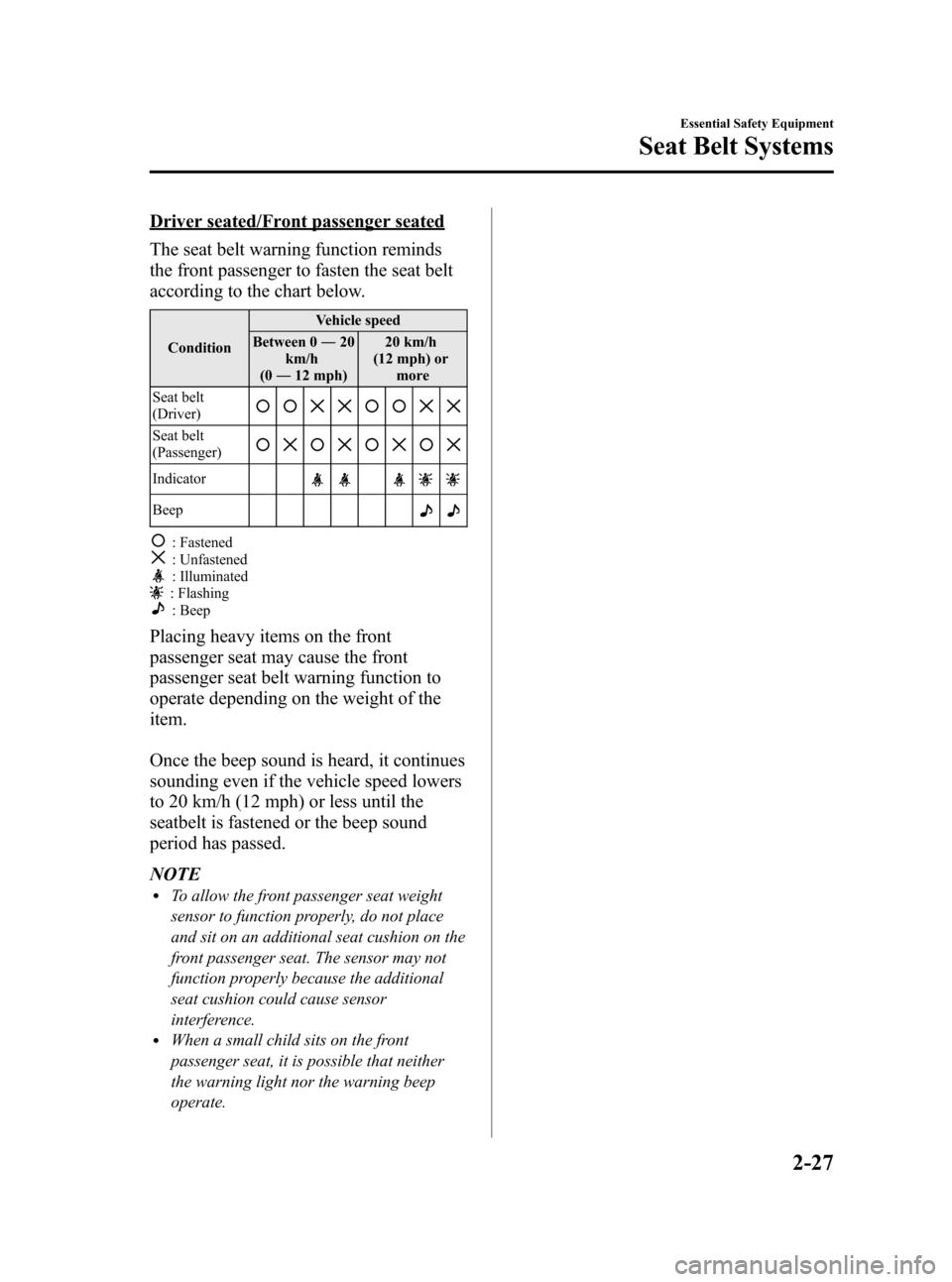
Black plate (41,1)
Driver seated/Front passenger seated
The seat belt warning function reminds
the front passenger to fasten the seat belt
according to the chart below.
ConditionVehicle speed
Between 0―20
km/h
(0―12 mph)20 km/h
(12 mph) or
more
Seat belt
(Driver)
Seat belt
(Passenger)
Indicator
Beep
: Fastened: Unfastened: Illuminated: Flashing: Beep
Placing heavy items on the front
passenger seat may cause the front
passenger seat belt warning function to
operate depending on the weight of the
item.
Once the beep sound is heard, it continues
sounding even if the vehicle speed lowers
to 20 km/h (12 mph) or less until the
seatbelt is fastened or the beep sound
period has passed.
NOTE
lTo allow the front passenger seat weight
sensor to function properly, do not place
and sit on an additional seat cushion on the
front passenger seat. The sensor may not
function properly because the additional
seat cushion could cause sensor
interference.
lWhen a small child sits on the front
passenger seat, it is possible that neither
the warning light nor the warning beep
operate.
Essential Safety Equipment
Seat Belt Systems
2-27
Mazda3_8AD6-EC-09A_Edition1 Page41
Tuesday, December 2 2008 2:26 PM
Form No.8AD6-EC-09A
Page 41 of 488
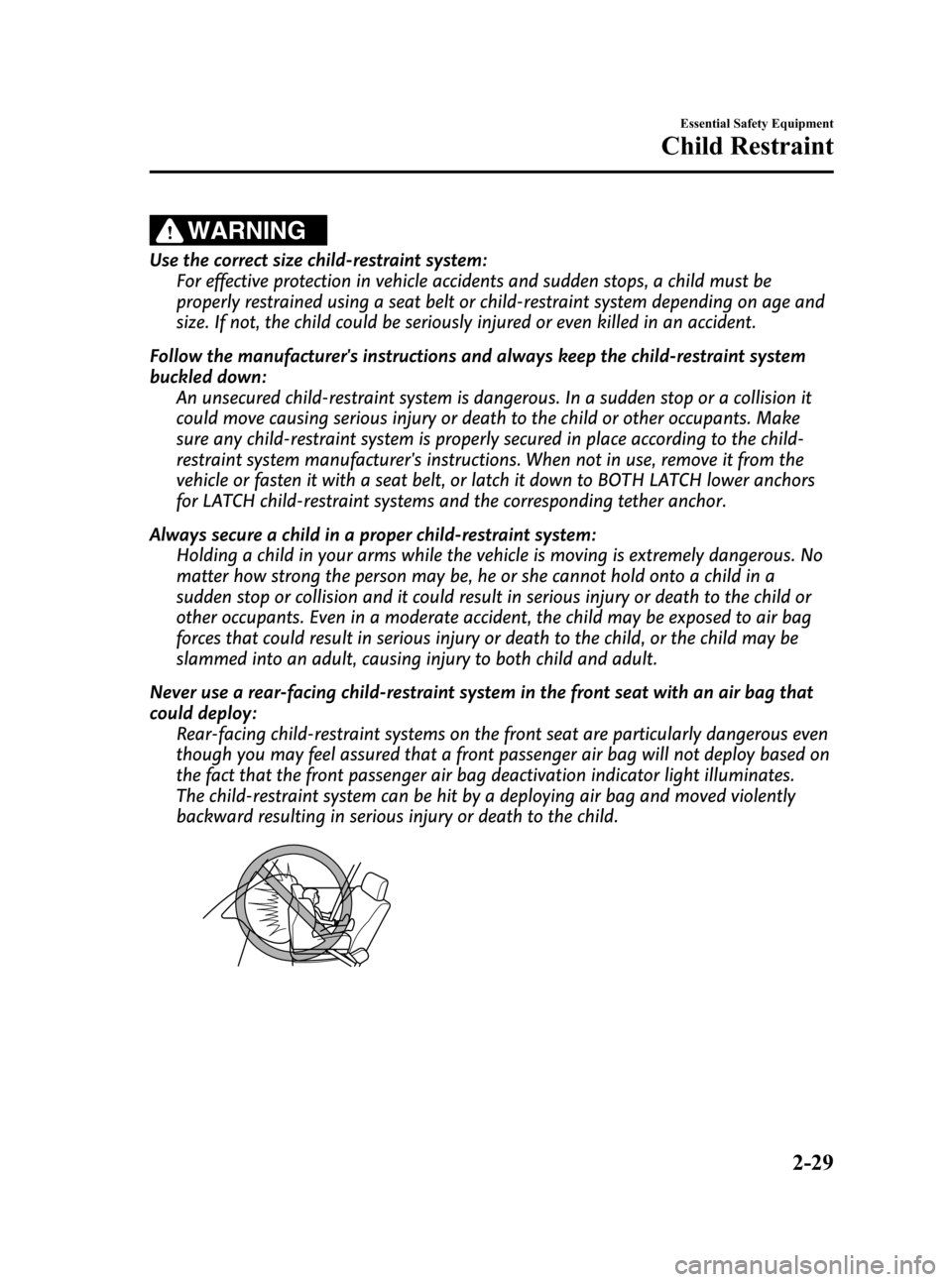
Black plate (43,1)
WARNING
Use the correct size child-restraint system:
For effective protection in vehicle accidents and sudden stops, a child must be
properly restrained using a seat belt or child-restraint system depending on age and
size. If not, the child could be seriously injured or even killed in an accident.
Follow the manufacturer's instructions and always keep the child-restraint system
buckled down:
An unsecured child-restraint system is dangerous. In a sudden stop or a collision it
could move causing serious injury or death to the child or other occupants. Make
sure any child-restraint system is properly secured in place according to the child-
restraint system manufacturer's instructions. When not in use, remove it from the
vehicle or fasten it with a seat belt, or latch it down to BOTH LATCH lower anchors
for LATCH child-restraint systems and the corresponding tether anchor.
Always secure a child in a proper child-restraint system:
Holding a child in your arms while the vehicle is moving is extremely dangerous. No
matter how strong the person may be, he or she cannot hold onto a child in a
sudden stop or collision and it could result in serious injury or death to the child or
other occupants. Even in a moderate accident, the child may be exposed to air bag
forces that could result in serious injury or death to the child, or the child may be
slammed into an adult, causing injury to both child and adult.
Never use a rear-facing child-restraint system in the front seat with an air bag that
could deploy:
Rear-facing child-restraint systems on the front seat are particularly dangerous even
though you may feel assured that a front passenger air bag will not deploy based on
the fact that the front passenger air bag deactivation indicator light illuminates.
The child-restraint system can be hit by a deploying air bag and moved violently
backward resulting in serious injury or death to the child.
Essential Safety Equipment
Child Restraint
2-29
Mazda3_8AD6-EC-09A_Edition1 Page43
Tuesday, December 2 2008 2:26 PM
Form No.8AD6-EC-09A
Page 44 of 488
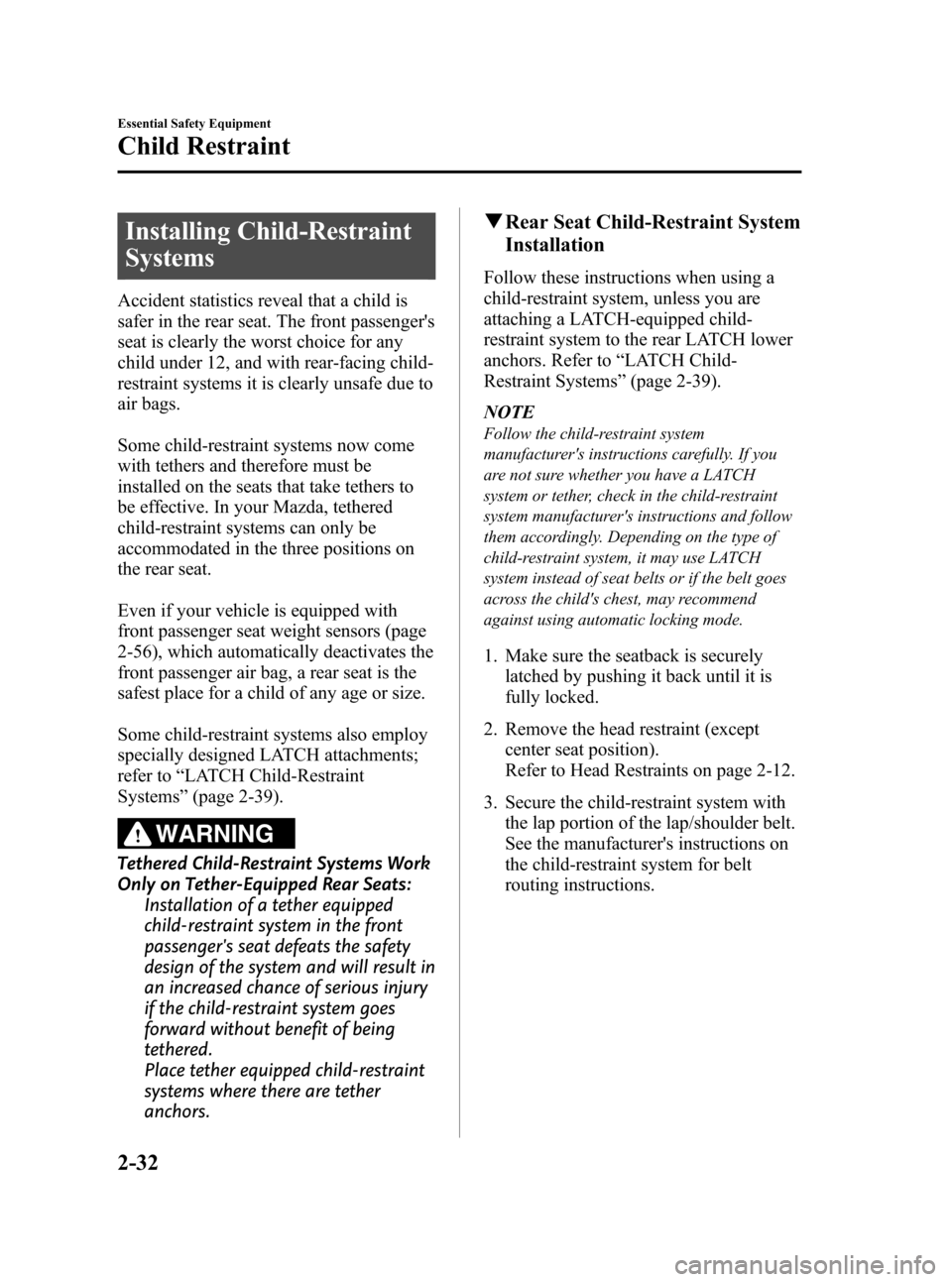
Black plate (46,1)
Installing Child-Restraint
Systems
Accident statistics reveal that a child is
safer in the rear seat. The front passenger's
seat is clearly the worst choice for any
child under 12, and with rear-facing child-
restraint systems it is clearly unsafe due to
air bags.
Some child-restraint systems now come
with tethers and therefore must be
installed on the seats that take tethers to
be effective. In your Mazda, tethered
child-restraint systems can only be
accommodated in the three positions on
the rear seat.
Even if your vehicle is equipped with
front passenger seat weight sensors (page
2-56), which automatically deactivates the
front passenger air bag, a rear seat is the
safest place for a child of any age or size.
Some child-restraint systems also employ
specially designed LATCH attachments;
refer to“LATCH Child-Restraint
Systems”(page 2-39).
WARNING
Tethered Child-Restraint Systems Work
Only on Tether-Equipped Rear Seats:
Installation of a tether equipped
child-restraint system in the front
passenger's seat defeats the safety
design of the system and will result in
an increased chance of serious injury
if the child-restraint system goes
forward without benefit of being
tethered.
Place tether equipped child-restraint
systems where there are tether
anchors.
qRear Seat Child-Restraint System
Installation
Follow these instructions when using a
child-restraint system, unless you are
attaching a LATCH-equipped child-
restraint system to the rear LATCH lower
anchors. Refer to“LATCH Child-
Restraint Systems”(page 2-39).
NOTE
Follow the child-restraint system
manufacturer's instructions carefully. If you
are not sure whether you have a LATCH
system or tether, check in the child-restraint
system manufacturer's instructions and follow
them accordingly. Depending on the type of
child-restraint system, it may use LATCH
system instead of seat belts or if the belt goes
across the child's chest, may recommend
against using automatic locking mode.
1. Make sure the seatback is securely
latched by pushing it back until it is
fully locked.
2. Remove the head restraint (except
center seat position).
Refer to Head Restraints on page 2-12.
3. Secure the child-restraint system with
the lap portion of the lap/shoulder belt.
See the manufacturer's instructions on
the child-restraint system for belt
routing instructions.
2-32
Essential Safety Equipment
Child Restraint
Mazda3_8AD6-EC-09A_Edition1 Page46
Tuesday, December 2 2008 2:26 PM
Form No.8AD6-EC-09A
Page 47 of 488
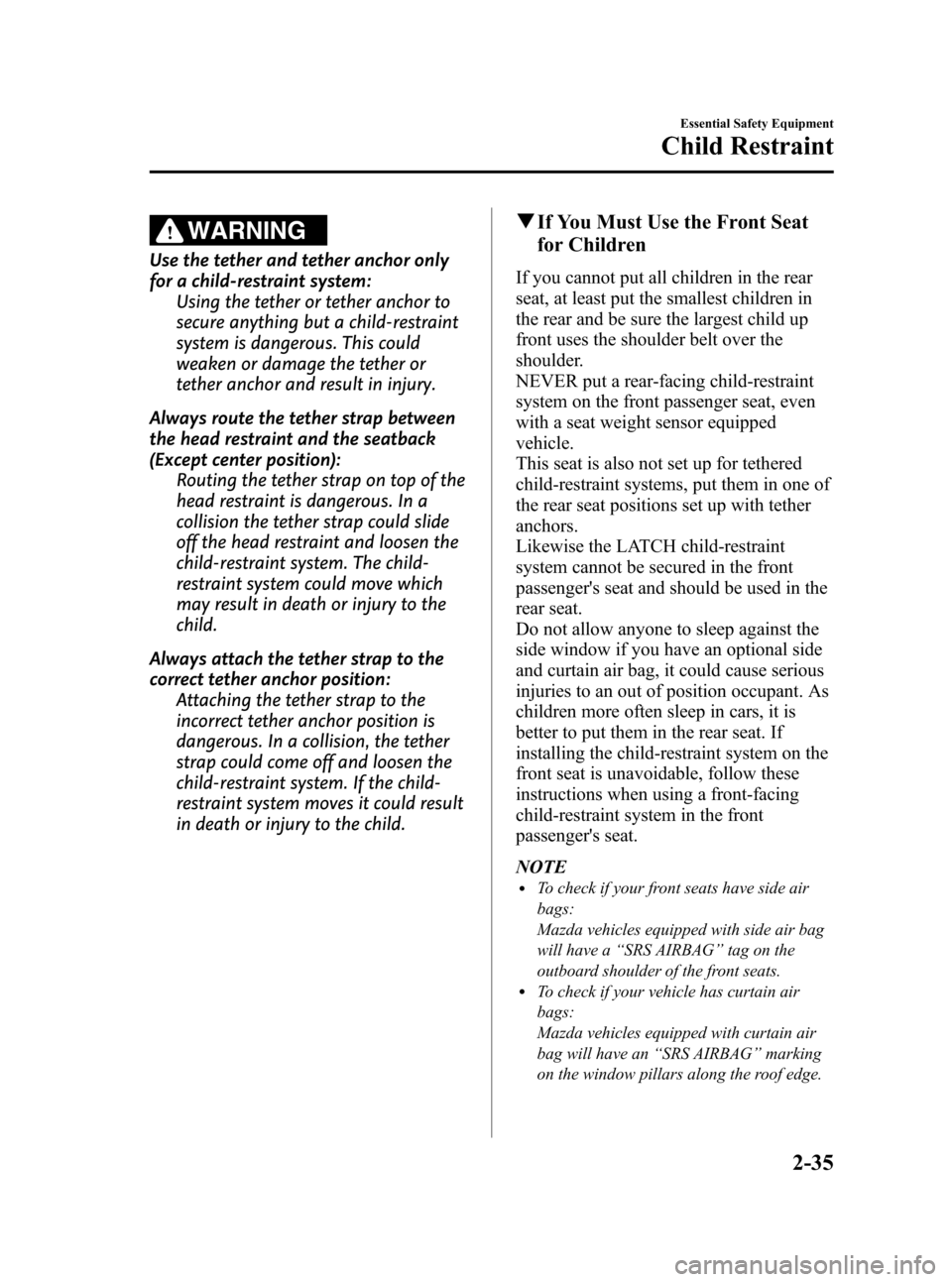
Black plate (49,1)
WARNING
Use the tether and tether anchor only
for a child-restraint system:
Using the tether or tether anchor to
secure anything but a child-restraint
system is dangerous. This could
weaken or damage the tether or
tether anchor and result in injury.
Always route the tether strap between
the head restraint and the seatback
(Except center position):
Routing the tether strap on top of the
head restraint is dangerous. In a
collision the tether strap could slide
off the head restraint and loosen the
child-restraint system. The child-
restraint system could move which
may result in death or injury to the
child.
Always attach the tether strap to the
correct tether anchor position:
Attaching the tether strap to the
incorrect tether anchor position is
dangerous. In a collision, the tether
strap could come off and loosen the
child-restraint system. If the child-
restraint system moves it could result
in death or injury to the child.
qIf You Must Use the Front Seat
for Children
If you cannot put all children in the rear
seat, at least put the smallest children in
the rear and be sure the largest child up
front uses the shoulder belt over the
shoulder.
NEVER put a rear-facing child-restraint
system on the front passenger seat, even
with a seat weight sensor equipped
vehicle.
This seat is also not set up for tethered
child-restraint systems, put them in one of
the rear seat positions set up with tether
anchors.
Likewise the LATCH child-restraint
system cannot be secured in the front
passenger's seat and should be used in the
rear seat.
Do not allow anyone to sleep against the
side window if you have an optional side
and curtain air bag, it could cause serious
injuries to an out of position occupant. As
children more often sleep in cars, it is
better to put them in the rear seat. If
installing the child-restraint system on the
front seat is unavoidable, follow these
instructions when using a front-facing
child-restraint system in the front
passenger's seat.
NOTE
lTo check if your front seats have side air
bags:
Mazda vehicles equipped with side air bag
will have a“SRS AIRBAG”tag on the
outboard shoulder of the front seats.
lTo check if your vehicle has curtain air
bags:
Mazda vehicles equipped with curtain air
bag will have an“SRS AIRBAG”marking
on the window pillars along the roof edge.
Essential Safety Equipment
Child Restraint
2-35
Mazda3_8AD6-EC-09A_Edition1 Page49
Tuesday, December 2 2008 2:26 PM
Form No.8AD6-EC-09A
Page 48 of 488
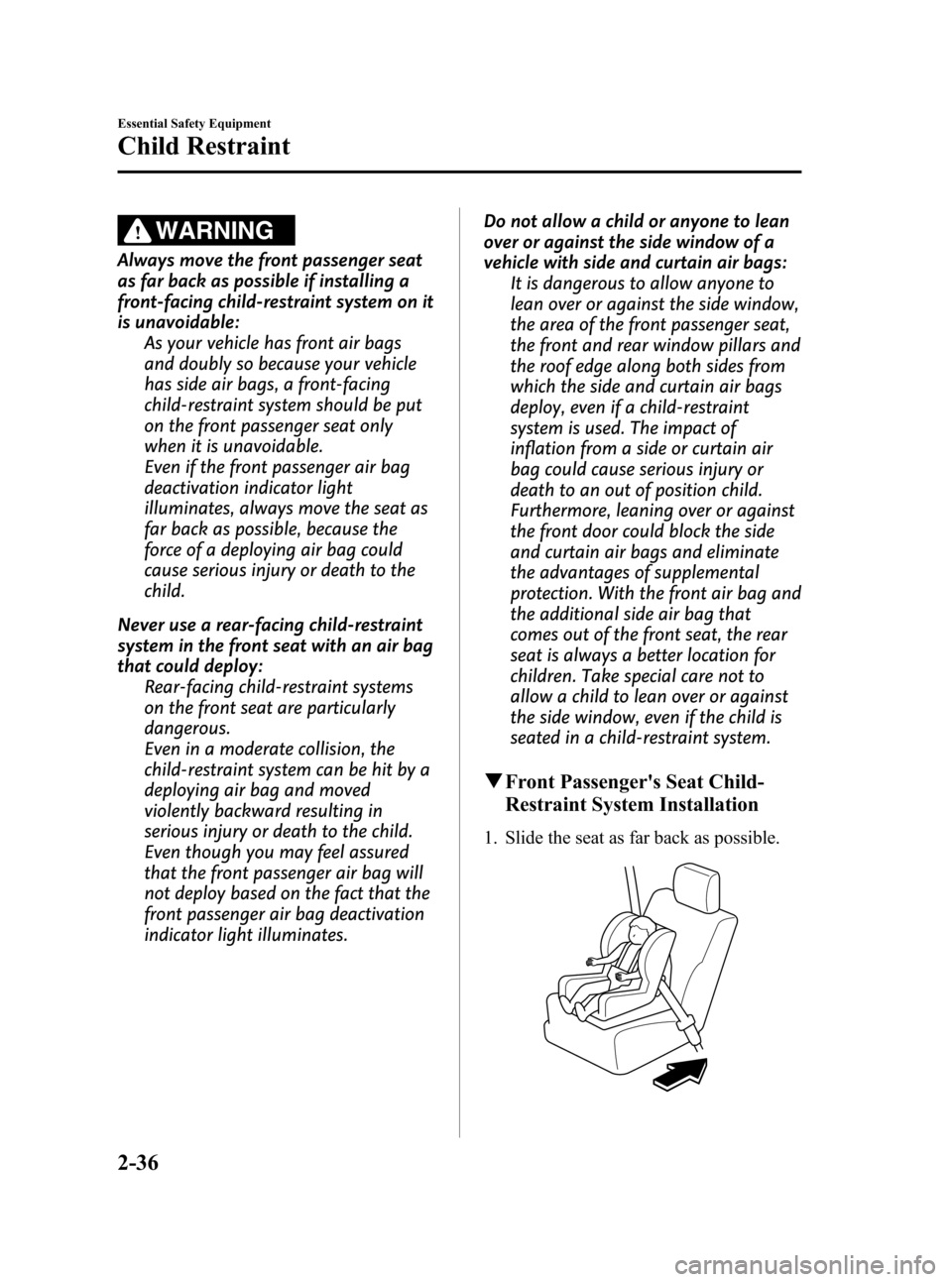
Black plate (50,1)
WARNING
Always move the front passenger seat
as far back as possible if installing a
front-facing child-restraint system on it
is unavoidable:
As your vehicle has front air bags
and doubly so because your vehicle
has side air bags, a front-facing
child-restraint system should be put
on the front passenger seat only
when it is unavoidable.
Even if the front passenger air bag
deactivation indicator light
illuminates, always move the seat as
far back as possible, because the
force of a deploying air bag could
cause serious injury or death to the
child.
Never use a rear-facing child-restraint
system in the front seat with an air bag
that could deploy:
Rear-facing child-restraint systems
on the front seat are particularly
dangerous.
Even in a moderate collision, the
child-restraint system can be hit by a
deploying air bag and moved
violently backward resulting in
serious injury or death to the child.
Even though you may feel assured
that the front passenger air bag will
not deploy based on the fact that the
front passenger air bag deactivation
indicator light illuminates.Do not allow a child or anyone to lean
over or against the side window of a
vehicle with side and curtain air bags:
It is dangerous to allow anyone to
lean over or against the side window,
the area of the front passenger seat,
the front and rear window pillars and
the roof edge along both sides from
which the side and curtain air bags
deploy, even if a child-restraint
system is used. The impact of
inflation from a side or curtain air
bag could cause serious injury or
death to an out of position child.
Furthermore, leaning over or against
the front door could block the side
and curtain air bags and eliminate
the advantages of supplemental
protection. With the front air bag and
the additional side air bag that
comes out of the front seat, the rear
seat is always a better location for
children. Take special care not to
allow a child to lean over or against
the side window, even if the child is
seated in a child-restraint system.
qFront Passenger's Seat Child-
Restraint System Installation
1. Slide the seat as far back as possible.
2-36
Essential Safety Equipment
Child Restraint
Mazda3_8AD6-EC-09A_Edition1 Page50
Tuesday, December 2 2008 2:26 PM
Form No.8AD6-EC-09A
Page 50 of 488
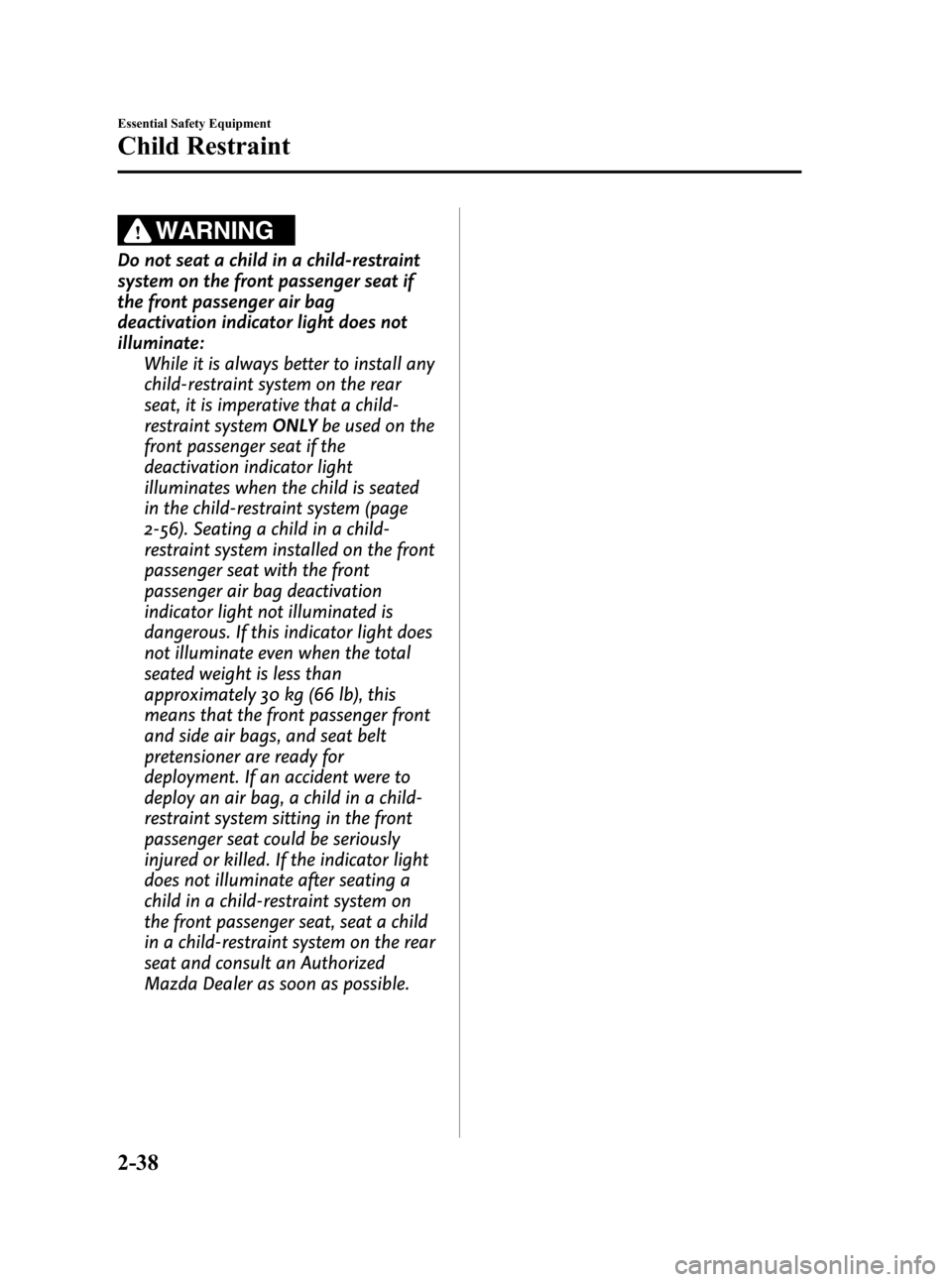
Black plate (52,1)
WARNING
Do not seat a child in a child-restraint
system on the front passenger seat if
the front passenger air bag
deactivation indicator light does not
illuminate:
While it is always better to install any
child-restraint system on the rear
seat, it is imperative that a child-
restraint systemONLYbe used on the
front passenger seat if the
deactivation indicator light
illuminates when the child is seated
in the child-restraint system (page
2-56). Seating a child in a child-
restraint system installed on the front
passenger seat with the front
passenger air bag deactivation
indicator light not illuminated is
dangerous. If this indicator light does
not illuminate even when the total
seated weight is less than
approximately 30 kg (66 lb), this
means that the front passenger front
and side air bags, and seat belt
pretensioner are ready for
deployment. If an accident were to
deploy an air bag, a child in a child-
restraint system sitting in the front
passenger seat could be seriously
injured or killed. If the indicator light
does not illuminate after seating a
child in a child-restraint system on
the front passenger seat, seat a child
in a child-restraint system on the rear
seat and consult an Authorized
Mazda Dealer as soon as possible.
2-38
Essential Safety Equipment
Child Restraint
Mazda3_8AD6-EC-09A_Edition1 Page52
Tuesday, December 2 2008 2:26 PM
Form No.8AD6-EC-09A
Page 51 of 488
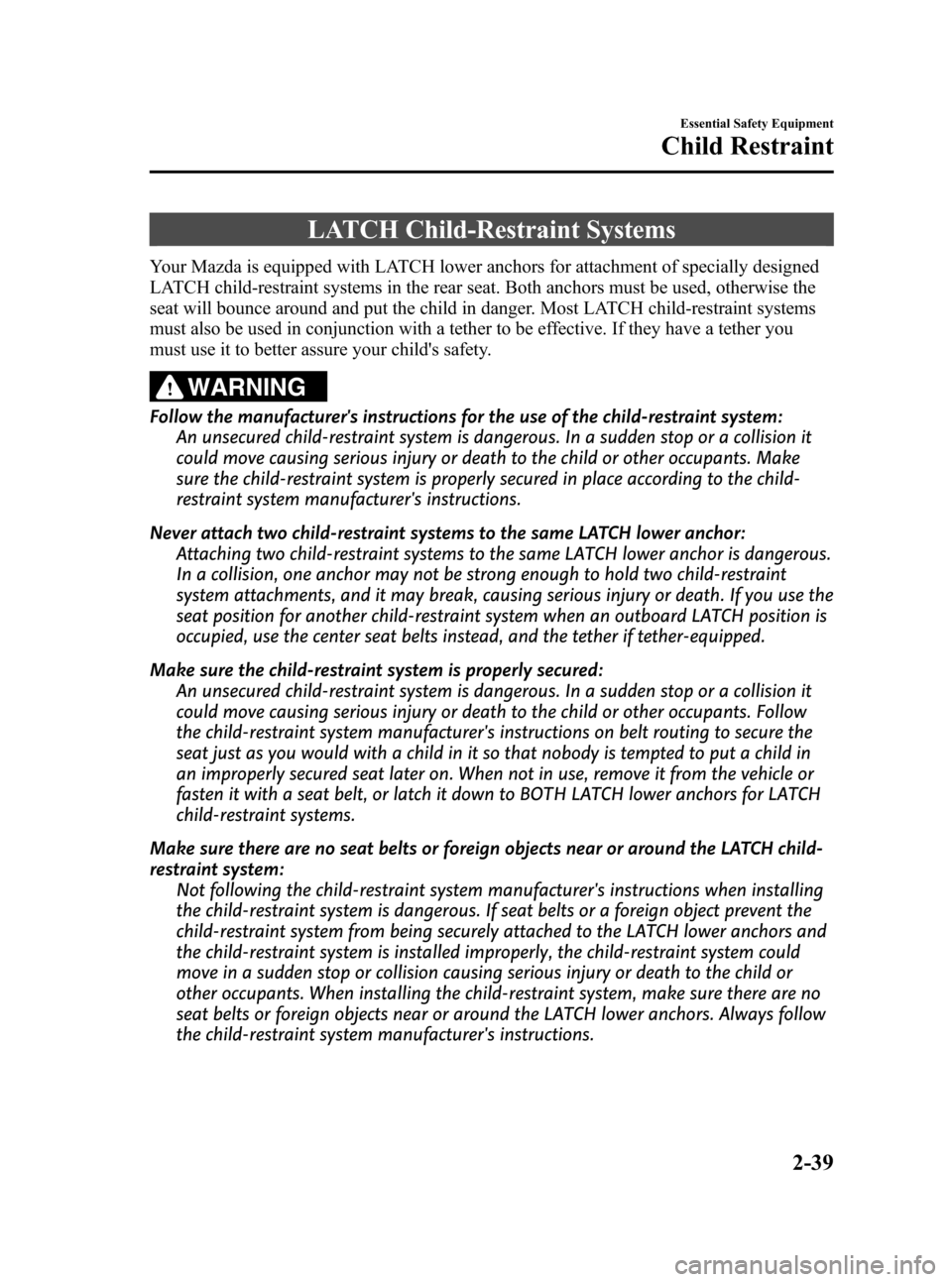
Black plate (53,1)
LATCH Child-Restraint Systems
Your Mazda is equipped with LATCH lower anchors for attachment of specially designed
LATCH child-restraint systems in the rear seat. Both anchors must be used, otherwise the
seat will bounce around and put the child in danger. Most LATCH child-restraint systems
must also be used in conjunction with a tether to be effective. If they have a tether you
must use it to better assure your child's safety.
WARNING
Follow the manufacturer's instructions for the use of the child-restraint system:
An unsecured child-restraint system is dangerous. In a sudden stop or a collision it
could move causing serious injury or death to the child or other occupants. Make
sure the child-restraint system is properly secured in place according to the child-
restraint system manufacturer's instructions.
Never attach two child-restraint systems to the same LATCH lower anchor:
Attaching two child-restraint systems to the same LATCH lower anchor is dangerous.
In a collision, one anchor may not be strong enough to hold two child-restraint
system attachments, and it may break, causing serious injury or death. If you use the
seat position for another child-restraint system when an outboard LATCH position is
occupied, use the center seat belts instead, and the tether if tether-equipped.
Make sure the child-restraint system is properly secured:
An unsecured child-restraint system is dangerous. In a sudden stop or a collision it
could move causing serious injury or death to the child or other occupants. Follow
the child-restraint system manufacturer's instructions on belt routing to secure the
seat just as you would with a child in it so that nobody is tempted to put a child in
an improperly secured seat later on. When not in use, remove it from the vehicle or
fasten it with a seat belt, or latch it down to BOTH LATCH lower anchors for LATCH
child-restraint systems.
Make sure there are no seat belts or foreign objects near or around the LATCH child-
restraint system:
Not following the child-restraint system manufacturer's instructions when installing
the child-restraint system is dangerous. If seat belts or a foreign object prevent the
child-restraint system from being securely attached to the LATCH lower anchors and
the child-restraint system is installed improperly, the child-restraint system could
move in a sudden stop or collision causing serious injury or death to the child or
other occupants. When installing the child-restraint system, make sure there are no
seat belts or foreign objects near or around the LATCH lower anchors. Always follow
the child-restraint system manufacturer's instructions.
Essential Safety Equipment
Child Restraint
2-39
Mazda3_8AD6-EC-09A_Edition1 Page53
Tuesday, December 2 2008 2:26 PM
Form No.8AD6-EC-09A
Page 53 of 488
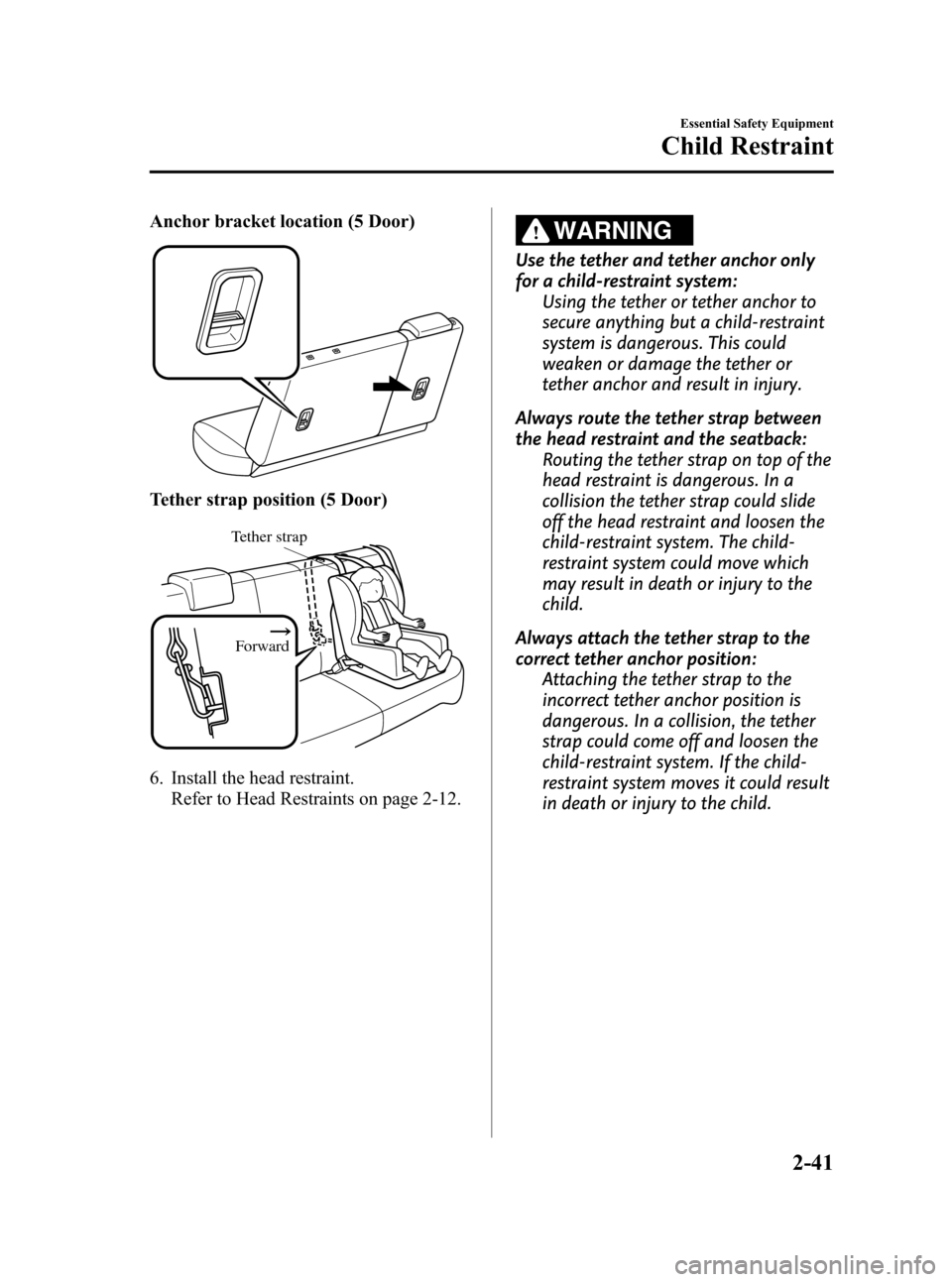
Black plate (55,1)
Anchor bracket location (5 Door)
Tether strap position (5 Door)
Forward
Tether strap
6. Install the head restraint.
Refer to Head Restraints on page 2-12.
WARNING
Use the tether and tether anchor only
for a child-restraint system:
Using the tether or tether anchor to
secure anything but a child-restraint
system is dangerous. This could
weaken or damage the tether or
tether anchor and result in injury.
Always route the tether strap between
the head restraint and the seatback:
Routing the tether strap on top of the
head restraint is dangerous. In a
collision the tether strap could slide
off the head restraint and loosen the
child-restraint system. The child-
restraint system could move which
may result in death or injury to the
child.
Always attach the tether strap to the
correct tether anchor position:
Attaching the tether strap to the
incorrect tether anchor position is
dangerous. In a collision, the tether
strap could come off and loosen the
child-restraint system. If the child-
restraint system moves it could result
in death or injury to the child.
Essential Safety Equipment
Child Restraint
2-41
Mazda3_8AD6-EC-09A_Edition1 Page55
Tuesday, December 2 2008 2:26 PM
Form No.8AD6-EC-09A
Page 54 of 488
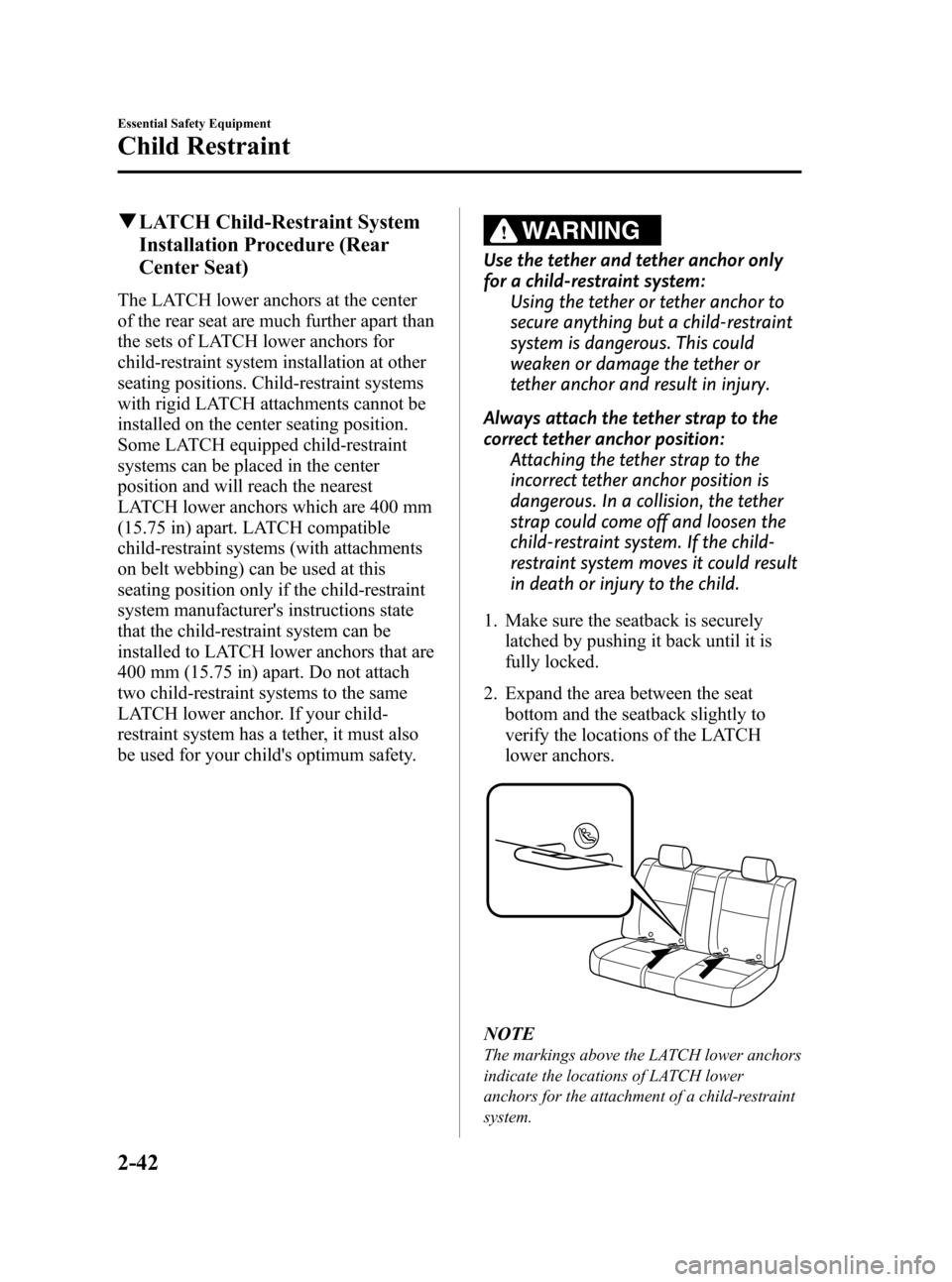
Black plate (56,1)
qLATCH Child-Restraint System
Installation Procedure (Rear
Center Seat)
The LATCH lower anchors at the center
of the rear seat are much further apart than
the sets of LATCH lower anchors for
child-restraint system installation at other
seating positions. Child-restraint systems
with rigid LATCH attachments cannot be
installed on the center seating position.
Some LATCH equipped child-restraint
systems can be placed in the center
position and will reach the nearest
LATCH lower anchors which are 400 mm
(15.75 in) apart. LATCH compatible
child-restraint systems (with attachments
on belt webbing) can be used at this
seating position only if the child-restraint
system manufacturer's instructions state
that the child-restraint system can be
installed to LATCH lower anchors that are
400 mm (15.75 in) apart. Do not attach
two child-restraint systems to the same
LATCH lower anchor. If your child-
restraint system has a tether, it must also
be used for your child's optimum safety.
WARNING
Use the tether and tether anchor only
for a child-restraint system:
Using the tether or tether anchor to
secure anything but a child-restraint
system is dangerous. This could
weaken or damage the tether or
tether anchor and result in injury.
Always attach the tether strap to the
correct tether anchor position:
Attaching the tether strap to the
incorrect tether anchor position is
dangerous. In a collision, the tether
strap could come off and loosen the
child-restraint system. If the child-
restraint system moves it could result
in death or injury to the child.
1. Make sure the seatback is securely
latched by pushing it back until it is
fully locked.
2. Expand the area between the seat
bottom and the seatback slightly to
verify the locations of the LATCH
lower anchors.
NOTE
The markings above the LATCH lower anchors
indicate the locations of LATCH lower
anchors for the attachment of a child-restraint
system.
2-42
Essential Safety Equipment
Child Restraint
Mazda3_8AD6-EC-09A_Edition1 Page56
Tuesday, December 2 2008 2:26 PM
Form No.8AD6-EC-09A
Page 57 of 488
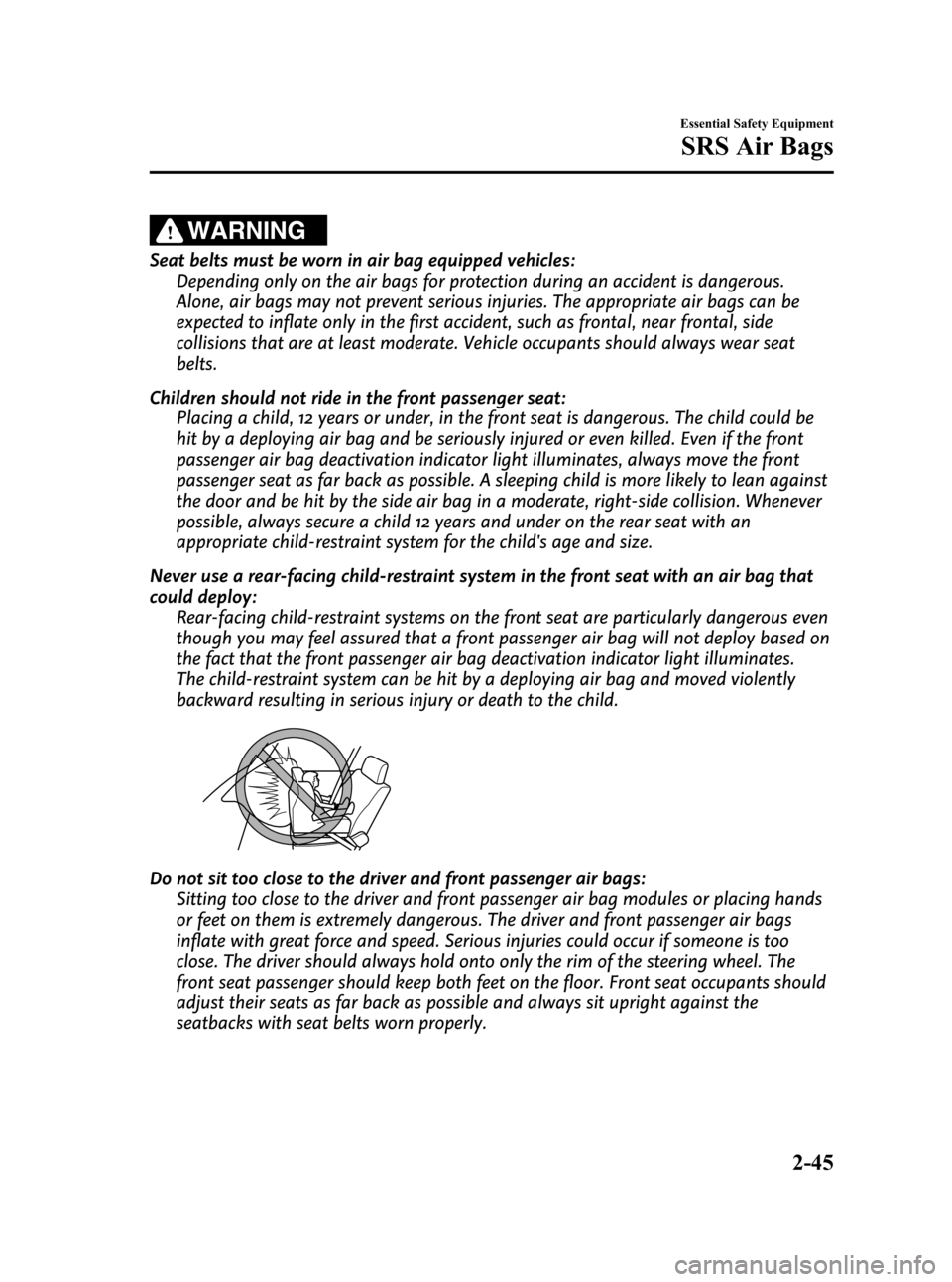
Black plate (59,1)
WARNING
Seat belts must be worn in air bag equipped vehicles:
Depending only on the air bags for protection during an accident is dangerous.
Alone, air bags may not prevent serious injuries. The appropriate air bags can be
expected to inflate only in the first accident, such as frontal, near frontal, side
collisions that are at least moderate. Vehicle occupants should always wear seat
belts.
Children should not ride in the front passenger seat:
Placing a child, 12 years or under, in the front seat is dangerous. The child could be
hit by a deploying air bag and be seriously injured or even killed. Even if the front
passenger air bag deactivation indicator light illuminates, always move the front
passenger seat as far back as possible. A sleeping child is more likely to lean against
the door and be hit by the side air bag in a moderate, right-side collision. Whenever
possible, always secure a child 12 years and under on the rear seat with an
appropriate child-restraint system for the child's age and size.
Never use a rear-facing child-restraint system in the front seat with an air bag that
could deploy:
Rear-facing child-restraint systems on the front seat are particularly dangerous even
though you may feel assured that a front passenger air bag will not deploy based on
the fact that the front passenger air bag deactivation indicator light illuminates.
The child-restraint system can be hit by a deploying air bag and moved violently
backward resulting in serious injury or death to the child.
Do not sit too close to the driver and front passenger air bags:
Sitting too close to the driver and front passenger air bag modules or placing hands
or feet on them is extremely dangerous. The driver and front passenger air bags
inflate with great force and speed. Serious injuries could occur if someone is too
close. The driver should always hold onto only the rim of the steering wheel. The
front seat passenger should keep both feet on the floor. Front seat occupants should
adjust their seats as far back as possible and always sit upright against the
seatbacks with seat belts worn properly.
Essential Safety Equipment
SRS Air Bags
2-45
Mazda3_8AD6-EC-09A_Edition1 Page59
Tuesday, December 2 2008 2:26 PM
Form No.8AD6-EC-09A